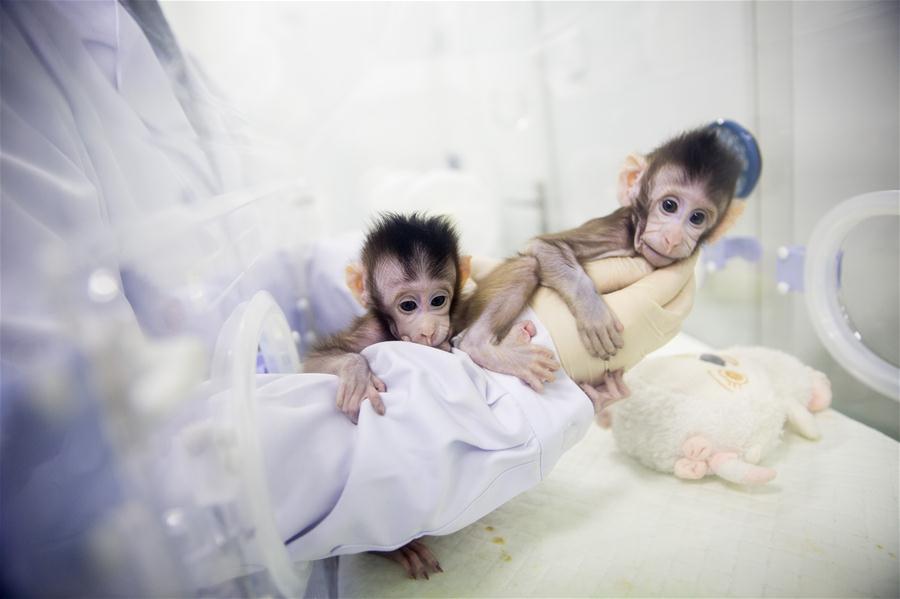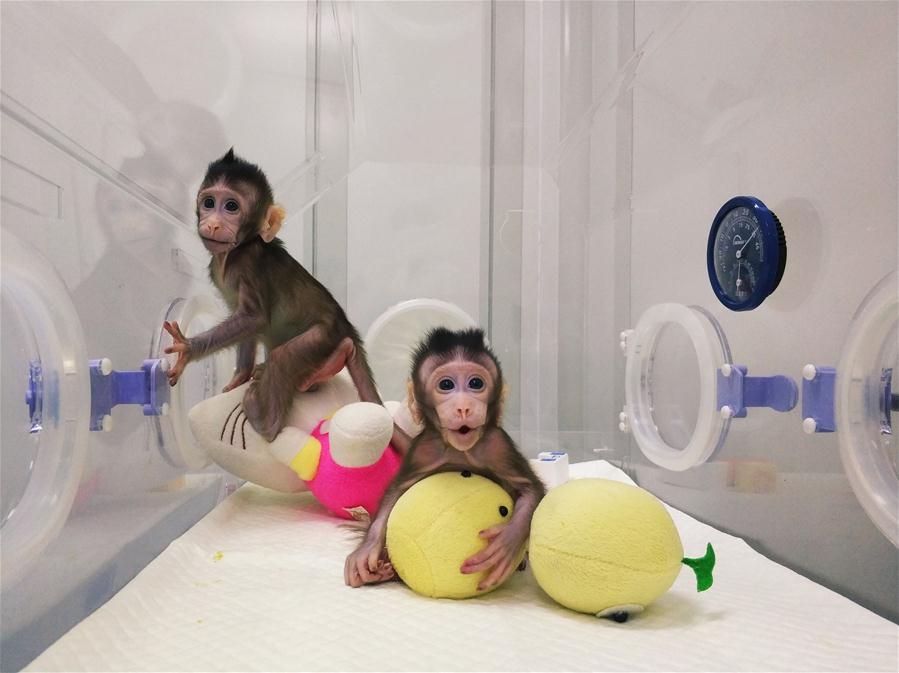


Two cloned macaques named Zhong Zhong and Hua Hua are held by a nurse at the non-human-primate research facility under the Chinese Academy of Sciences (CAS) in Suzhou, east China's Jiangsu province, Jan. 22, 2018. China on Thursday announced it successfully cloned world's first macaques from somatic cells by method that made Dolly. (Xinhua/Jin Liwang)
Beijing (People's Daily) – Researchers in China officially made history on Wednesday when it was announced they had successfully cloned two monkeys.
Zhong Zhong and Hua Hua, both female monkeys, were cloned from fetal fibroblasts, a cell found in connective tissue.
The cloning method involves removing the nucleus from a donor egg cell and replacing it with one taken out of a cell from another animal.
Somatic cells are a concept relative to germ cells. It is a type of cell whose genetic information does not pass to the next generation like germ cells.
Zhong Zhong was born on November 27, and Hua Hua was born on Christmas Day.
Both monkeys are in good health under the watchful eyes of a research team that has been working on the clone project for five years.

File photo provided by the Chinese Academy of Sciences shows two cloned macaques named Zhong Zhong and Hua Hua at the non-human-primate research facility under the Chinese Academy of Sciences. China on Thursday announced it successfully cloned world's first macaques from somatic cells by method that made Dolly. (Xinhua)
Research team leader, Sun Qiang, at the Institute of Neuroscience and Center for Excellence in Brain Science and Intelligence Technology Chinese Academy of Sciences in Shanghai.
Since “Dolly’ was cloned in Scotland in 1996, scientists have successfully used SCNT to clone more than 20 other species, including cows, pigs, dogs, rabbits, rats and mice.
But cloning primates had always remained elusive.
The Chinese team succeeded by using modulators to switch on or off certain genes that were inhibiting embryo development.
“After this technology matures, the future, China can also be built to nonhuman primates as a model of the main research and development base and industrial chain,” said scientist Pu Muming.

 Award-winning photos show poverty reduction achievements in NE China's Jilin province
Award-winning photos show poverty reduction achievements in NE China's Jilin province People dance to greet advent of New Year in Ameiqituo Town, Guizhou
People dance to greet advent of New Year in Ameiqituo Town, Guizhou Fire brigade in Shanghai holds group wedding
Fire brigade in Shanghai holds group wedding Tourists enjoy ice sculptures in Datan Town, north China
Tourists enjoy ice sculptures in Datan Town, north China Sunset scenery of Dayan Pagoda in Xi'an
Sunset scenery of Dayan Pagoda in Xi'an Tourists have fun at scenic spot in Nanlong Town, NW China
Tourists have fun at scenic spot in Nanlong Town, NW China Harbin attracts tourists by making best use of ice in winter
Harbin attracts tourists by making best use of ice in winter In pics: FIS Alpine Ski Women's World Cup Slalom
In pics: FIS Alpine Ski Women's World Cup Slalom Black-necked cranes rest at reservoir in Lhunzhub County, Lhasa
Black-necked cranes rest at reservoir in Lhunzhub County, Lhasa China's FAST telescope will be available to foreign scientists in April
China's FAST telescope will be available to foreign scientists in April